
Building an effective disaster recovery plan is crucial for any organization, as it helps minimize the impact of unforeseen events and ensures business continuity. By identifying potential risks, creating an emergency response strategy, and safeguarding data, businesses can recover and resume operations with minimal disruption. This article will explore key components that should be included in a comprehensive disaster recovery plan.
Building Blocks of an Effective Disaster Recovery Strategy
When developing a disaster recovery plan, it is important to consider several key building blocks that form the foundation of an effective strategy. These include:

- Business Impact Analysis
- Risk Assessment and Mitigation
- Emergency Response Strategy
- Data Protection and Recovery
- Communication Plan
- Recovery Team Roles and Responsibilities
- Prioritization of Systems and Applications
- Recovery Time Objective (RTO) and Recovery Point Objective (RPO)
- Regular Plan Updates
- Training and Awareness
Understanding the Importance of Business Impact Analysis
One of the first steps in building a disaster recovery plan is conducting a thorough business impact analysis. This process helps identify critical business functions, dependencies, and the potential impact of disruptions on these functions. By understanding the priorities and interdependencies within the organization, businesses can allocate resources effectively and ensure a focused recovery strategy.
Identifying and Mitigating Risks Through Thorough Assessment
A comprehensive risk assessment is essential for identifying potential risks and vulnerabilities that could impact business operations. By evaluating threats such as natural disasters, cyber attacks, or equipment failures, organizations can implement appropriate mitigation measures. This may include implementing robust security measures, implementing redundant systems, or establishing off-site data backups.
Crafting an Effective Emergency Response Strategy
In the event of a disaster, an effective emergency response strategy can significantly reduce downtime and minimize the impact on business operations. This strategy should include clear guidelines for immediate actions, communication protocols, and designated roles and responsibilities. Regular drills and training sessions can ensure that employees are well-prepared to respond quickly and efficiently during an emergency.
Safeguarding Your Data: The Key to Successful Recovery
Data protection and recovery are critical components of a disaster recovery plan. Organizations should implement robust backup and recovery solutions to ensure that essential data is regularly backed up and easily recoverable. This may include creating off-site backups, implementing data encryption, and establishing data recovery procedures to minimize data loss and downtime.
The Power of Communication in Disaster Recovery
Effective communication is crucial during a disaster recovery process. Organizations should establish clear channels of communication to keep employees, stakeholders, and customers informed about the recovery progress. This includes providing frequent updates, establishing an internal communication system, and having a designated spokesperson to address questions and concerns.
Forming a Strong Recovery Team: Roles and Responsibilities
A strong recovery team is essential for executing the disaster recovery plan effectively. This team should consist of individuals with specific roles and responsibilities, such as a disaster recovery coordinator, IT specialists, and department leaders. By clearly defining roles and providing appropriate training, organizations can ensure a coordinated and efficient recovery process.
Prioritizing Systems and Applications for Seamless Recovery
During a disaster recovery process, not all systems and applications are created equal. It is essential to prioritize critical systems and applications that are crucial for business continuity. By categorizing systems based on importance and implementing recovery strategies accordingly, organizations can minimize downtime and resume operations swiftly.
Setting the Right Goals: RTO and RPO Explained
Recovery Time Objective (RTO) and Recovery Point Objective (RPO) are two key metrics in disaster recovery. RTO defines the maximum acceptable downtime for systems, applications, and processes, while RPO refers to the maximum acceptable data loss. By setting realistic RTO and RPO goals, organizations can align their recovery efforts with business requirements and ensure minimal disruption.
The Importance of Regularly Updating Your Disaster Recovery Plan
A disaster recovery plan should not be a static document. It is essential to regularly review and update the plan to account for changes in technology, infrastructure, or business requirements. By conducting regular audits and tests, organizations can identify gaps or weaknesses in the plan and make necessary adjustments to enhance its effectiveness.
Empowering Your Team: Training and Awareness for Effective Recovery
An empowered and well-trained team is crucial for successful disaster recovery. Organizations should invest in training programs to ensure that employees are aware of their roles and responsibilities during a disaster. Regular training sessions and awareness campaigns can help promote a culture of preparedness and enhance the overall effectiveness of the recovery strategy.
As you can see, each building block plays a vital role in creating a comprehensive and effective disaster recovery plan. By considering these elements and taking proactive measures to address potential risks, organizations can minimize the impact of disasters and ensure the continuity of their operations. Remember, a well-designed disaster recovery plan is an essential investment to protect the continuity and reputation of any business.
If You would like to learn more about our Managed IT Support Services then click the link below


